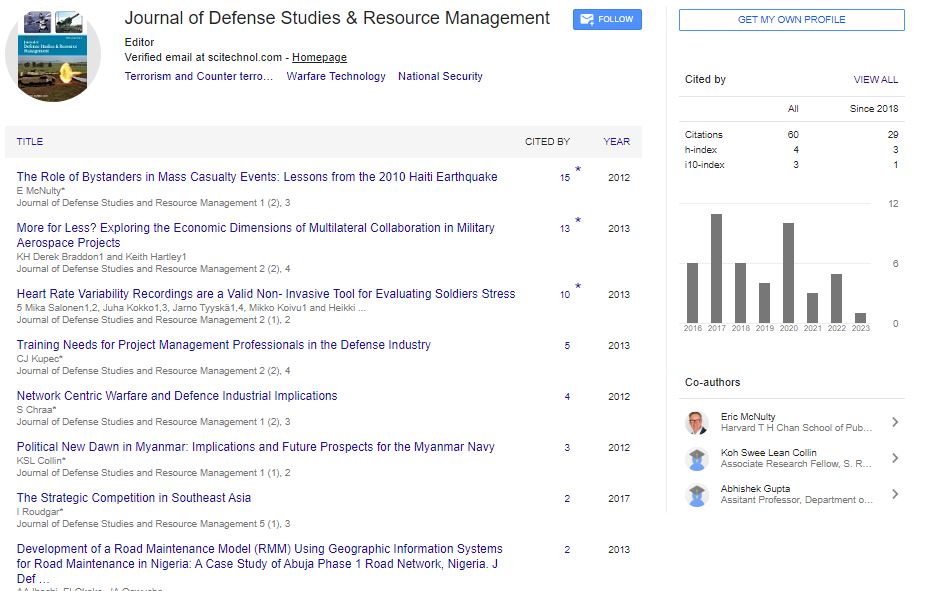Short Communication, J Def Stud Resour Manage Vol: 11 Issue: 1
Emergency Preparedness and Response Planning in the Defense Sector
Kostas Spring*
Department of Management Science, Lancaster University Management School, Lancaster, United Kingdom
*Corresponding Author: Kostas Spring
Department of Management Science,
Lancaster University Management School, Lancaster, United Kingdom
E-mail: k.spring@lancaster.ac.uk
Received date: 01 March, 2023, Manuscript No. JDSRM-23-93377;
Editor assigned date: 03 March, 2023, Pre QC No. JDSRM-23-93377 (PQ);
Reviewed date: 17 March, 2023, QC No. JDSRM-23-93377;
Revised date: 24 March, 2023, Manuscript No. JDSRM-23-93377(R);
Published date: 31 March, 2023, DOI: 10.4172/2324-9315.1000166
Citation: Spring K (2023) Emer gency Preparedness and Response Planning in the Defense Sector. J Def Stud Resour Manage 11:1.
Description
The defense sector faces a range of emergencies and disasters that threaten military personnel, installations, and operations. Emergency preparedness and response planning is essential to ensure the safety of military personnel and the continuity of operations. In the defense sector, emergency preparedness and response planning is an ongoing process that requires ongoing review and revision. This article will explore the importance of emergency preparedness and response planning in the defense sector, including the key components of a successful plan and the challenges of implementing such a plan [1].
The defense sector must be prepared to respond to a wide range of emergencies, including natural disasters, terrorist attacks, and other man-made crises. These emergencies can result in loss of life, damage to infrastructure and equipment, and disruption of operations. A comprehensive emergency preparedness and response plan is essential to ensure that the defense sector is prepared to respond quickly and effectively to any emergency [2].
There are several key components of an effective emergency preparedness and response plan in the defense sector. These include.
A comprehensive risk assessment is essential to identify potential emergencies and their impact on the defense sector. This includes identifying the probability and potential impact of emergencies, as well as the resources needed to respond to them [3].
The emergency response team should be composed of highly trained and experienced personnel who are prepared to respond quickly and effectively to any emergency. This includes personnel responsible for managing the emergency response, as well as those responsible for providing medical assistance, security, and other support services.
A clear and effective communication plan is essential to ensure that all personnel are aware of the emergency and the necessary response. This includes communication protocols for notifying personnel of emergencies, as well as procedures for communicating with external agencies and stakeholders [4].
An Emergency Operations Center (EOC) is the central command center where emergency response activities are coordinated. The EOC should be equipped with the necessary equipment and technology to support emergency response activities, including communication equipment, data management systems, and emergency power [5].
Training and exercises are essential to ensure that all personnel are prepared to respond quickly and effectively to any emergency. This includes regular training for emergency response personnel, as well as exercises to test the effectiveness of the emergency response plan [6].
Implementing an emergency preparedness and response plan in the defense sector can be challenging due to several factors.The defense sector may face limited resources, including funding, personnel, and equipment, which can make it difficult to implement an effective emergency preparedness and response plan [7].
The defense sector may need to work with other agencies, such as law enforcement, emergency services, and government agencies, to respond to emergencies. Interagency coordination can be challenging due to differences in policies, procedures, and communication protocols [8].
The defense sector may face rapidly evolving threats, such as cyber-attacks and terrorism, which can make it difficult to anticipate and respond to emergencies [9].
The organizational culture of the defense sector can also pose challenges to emergency preparedness and response planning. For example, a culture that values hierarchy and following established procedures may hinder flexibility and innovation in emergency response [10].
Conclusion
Emergency preparedness and response planning is essential in the defense sector to ensure the safety of military personnel and the continuity of operations. An effective plan should include a comprehensive risk assessment, an emergency response team, a clear communication plan, an EOC, and regular training and exercises. Implementing such a plan can be challenging due to limited resources, interagency coordination, rapidly evolving threats, and organization.
References
- Hartley K (1995) Industrial policies in the defense sector. Handbook of defense economics 1 459-489.
- Segura ER, Marcos IO, Romero JJ, Segura JT (2016) Critical success factors in large projects in the aerospace and defense sectors. J Bus Res 69(11): 5419-5425.
- Barros CP (2004) Measuring performance in defense‐sector companies in a small NATO member country. J Econ Stud 31(2) 112-128.
- Cui H, Gobbato E, Kracher B, Qiu J, Bautor J et al., (2017) A core function of EDS1 with PAD4 is to protect the salicylic acid defense sector in Arabidopsis immunity. New Phytol 213(4): 1802-1817.
- Tom R (1985) Concentration and inefficiency in the defense sector: Policy options. J Econ Issues 19(2): 451-461.
- Naseer A, Eldabi T, Jahangirian M (2009) Cross‐sector analysis of simulation methods: a survey of defense and healthcare. Transforming Government: People Process and Policy 3(2):181-189.
- Hawkins TG, Gravier MJ, Berkowitz D, Muir WA (2015) Improving services supply management in the defense sector: How the procurement process affects B2B service quality. Journal of Purchasing and Supply Management 21(2): 81-94.
- Heo Uk (1998) Modeling the defense-growth relationship around the globe. J Conflict Resolut 42(5): 637-657.
- Fiott D (2014) Reducing the environmental boot print? Competition and regulation in the greening of Europe’s defense sector. Organization & Environment 27(3): 263-278.
- Mueller H, Michael J, Atesoglu S (1993) Defense spending, technological change, and economic growth in the United States. Defense and Peace Economics 4(3): 259-269.
 Spanish
Spanish  Chinese
Chinese  Russian
Russian  German
German  French
French  Japanese
Japanese  Portuguese
Portuguese  Hindi
Hindi 